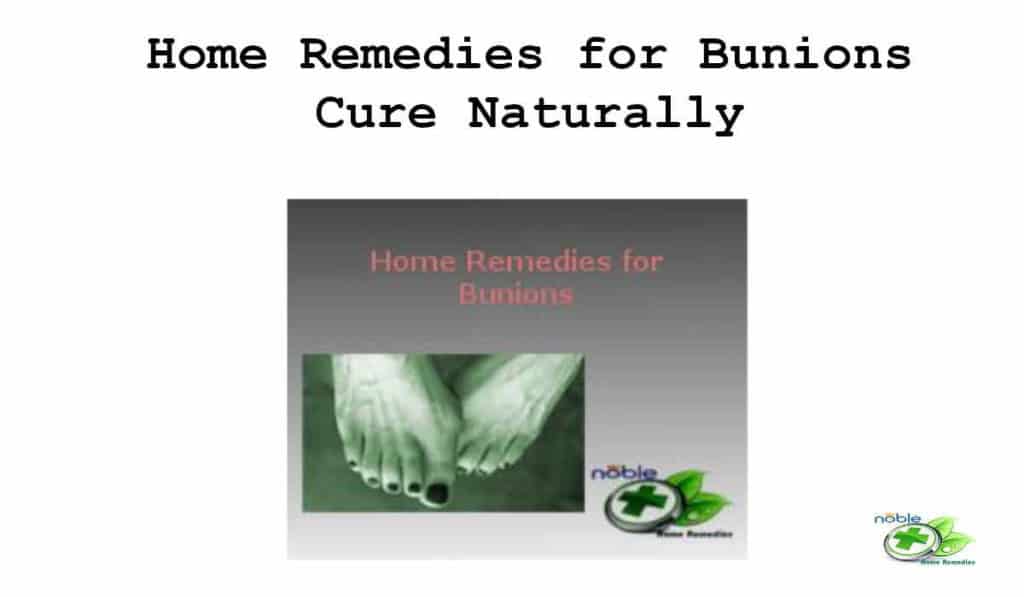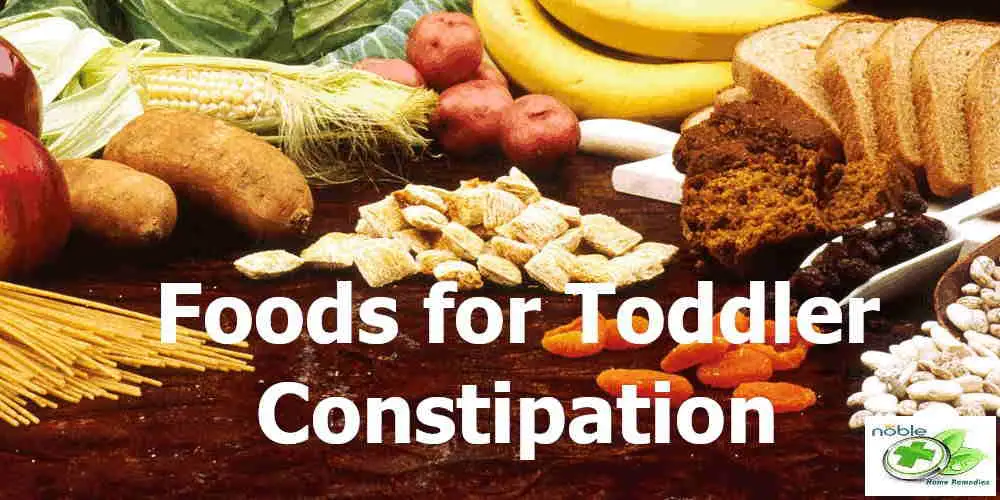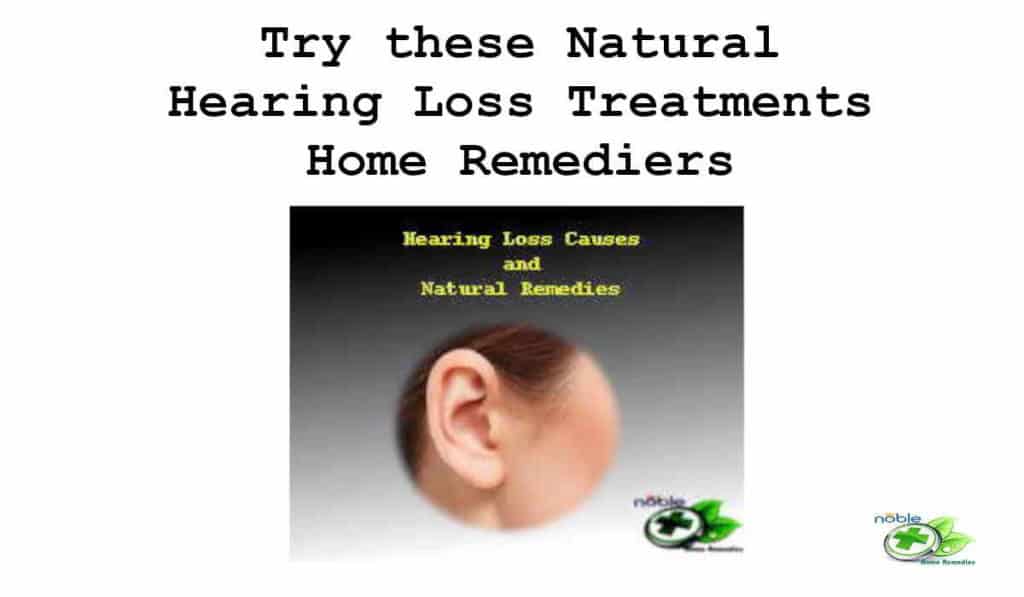How to Get Rid of Dandruff: 10 Natural Dandruff Remedies That Actually Work
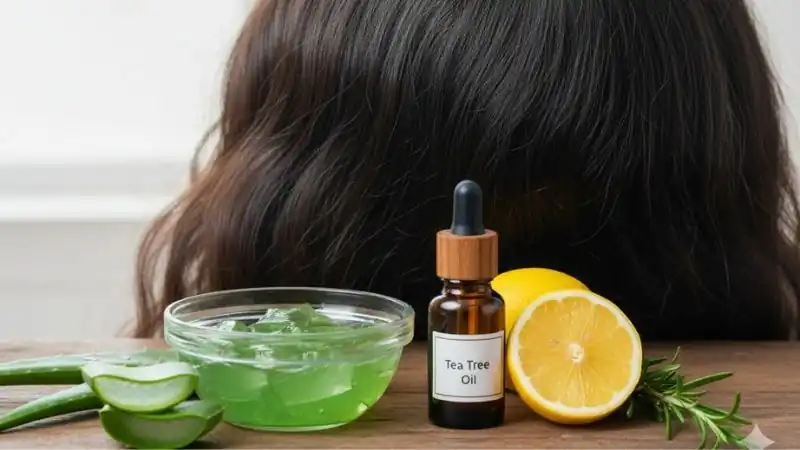
Have you ever felt that uncomfortable tingle on your scalp, only to notice white flakes dusting your shoulders like unwelcome snow? You’re definitely not alone. Research shows that nearly half of all adults worldwide struggle with dandruff at some point in their lives. The embarrassment, the constant itching, and the frustration of trying product after product can feel overwhelming.
But here’s the good news: dandruff is highly treatable, and you don’t always need expensive salon treatments or harsh chemical shampoos to win this battle. Natural dandruff remedies have been used for centuries, and science now backs many of these traditional solutions with solid research.
In this comprehensive guide, you’ll discover the root causes of dandruff, learn 10 proven home remedies backed by science, and understand exactly how to create a treatment plan that works for your unique scalp. Whether you’re dealing with occasional flakes or persistent itching, you’ll find practical, affordable solutions that can transform your scalp health starting today.
What Is Dandruff and Why Does It Happen?
Understanding the Flaky Problem
Dandruff is a common scalp condition where dead skin cells are shed excessively, creating those visible white or yellowish flakes you see on your hair and shoulders. While it’s not contagious or dangerous, it can certainly affect your confidence and comfort.
Your scalp naturally sheds dead skin cells as part of its renewal process. However, when this shedding accelerates or becomes irregular, those cells clump together with scalp oils, forming the noticeable flakes we call dandruff. Sometimes dandruff is linked to seborrheic dermatitis, a more severe inflammatory condition that causes red, greasy patches alongside the flaking.
The Real Culprits Behind Your Dandruff
Understanding what causes your dandruff is the first step toward finding effective dandruff remedies. Here are the main triggers:
- Malassezia Yeast Overgrowth: This is the number one cause of dandruff. Malassezia is a naturally occurring fungus that lives on everyone’s scalp, feeding on the oils your skin produces. When it grows out of control, it irritates your scalp and speeds up cell turnover, causing excessive flaking.
- Oil Production Imbalances: Too much sebum (natural scalp oil) creates the perfect environment for Malassezia to thrive. Ironically, overly dry scalps can also cause flaking, though the flakes are typically smaller and less oily.
- Inadequate Hair Washing: Not shampooing enough allows oil and dead skin cells to build up, while washing too frequently can strip your scalp of protective oils. Finding your personal balance is key.
- Sensitivity to Hair Products: Some ingredients in shampoos, conditioners, and styling products can trigger contact dermatitis, causing redness, itching, and flaking.
- Stress and Diet: High stress levels weaken your immune system, making it harder to control fungal overgrowth. Similarly, a diet lacking essential nutrients like zinc, B vitamins, and healthy fats can contribute to scalp problems.
- Weather Changes: Cold, dry winter air often worsens dandruff symptoms, while indoor heating further dehydrates your scalp.
Recognizing Dandruff Symptoms
Beyond the obvious white flakes, watch for these signs:
- Persistent itching that makes you want to scratch constantly
- Red or irritated patches on your scalp
- Greasy-looking flakes (yellowish in color)
- Tingly or burning sensations on the scalp
- In severe cases, hair loss from constant scratching and inflammation
If you experience thick, crusty scales or symptoms spreading to your face, eyebrows, or chest, you may have seborrheic dermatitis rather than simple dandruff. In these cases, seeing a dermatologist is wise.
15+ Proven Natural Dandruff Remedies You Can Try at Home
Ready to tackle that flaky scalp naturally? These evidence-based home remedies for dandruff offer powerful solutions without harsh chemicals.
1. Tea Tree Oil: Nature’s Antifungal Powerhouse
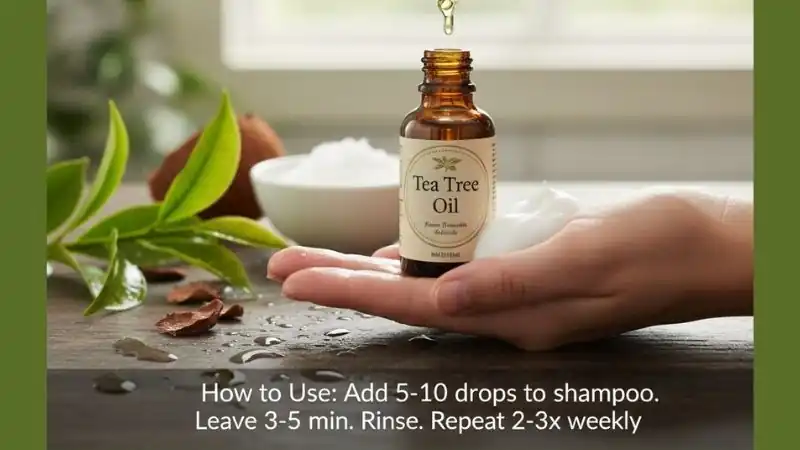
Tea tree oil has earned its reputation as one of the most effective natural dandruff remedies. Its powerful antifungal and antimicrobial properties directly combat the Malassezia yeast responsible for most dandruff cases.
Research published in the Journal of the American Academy of Dermatology found that shampoo containing just 5% tea tree oil reduced dandruff by 41% after four weeks of use. The study participants also reported significant decreases in itchiness and greasiness.
How to Use Tea Tree Oil for Dandruff:
- Add 5-10 drops of pure tea tree essential oil to your regular shampoo (about a quarter-sized amount)
- Mix well and massage gently into your wet scalp
- Leave the lather on for 3-5 minutes to allow the oil to penetrate
- Rinse thoroughly with lukewarm water
- Repeat 2-3 times weekly for best results
Pro Tip: You can also create a pre-shampoo treatment by diluting 3-4 drops of tea tree oil in 2 tablespoons of coconut or olive oil. Massage into your scalp, leave for 30 minutes, then shampoo normally.
2. Coconut Oil: Deep Moisture Meets Antifungal Action
Coconut oil contains lauric acid, a medium-chain fatty acid with impressive antifungal properties that help eliminate the fungus causing your dandruff. It also deeply moisturizes dry, irritated scalps and reduces inflammation.
Scientific studies demonstrate that coconut oil effectively reduces both bacteria and fungus on the scalp while improving overall scalp health. However, if you have an extremely oily scalp, coconut oil might worsen your symptoms, so proceed cautiously and monitor your results.
Coconut Oil Dandruff Treatment Recipe:
- Warm 3-5 tablespoons of virgin coconut oil until it’s liquid but not hot
- Part your hair into sections and apply the oil directly to your scalp
- Massage gently using circular motions for 5-10 minutes
- Leave on for at least 1 hour (or overnight for intensive treatment)
- Wash out thoroughly with a gentle shampoo
- Repeat 2-3 times weekly
Variation: Mix equal parts coconut oil and lemon juice for enhanced antifungal benefits. The citric acid in lemon helps balance your scalp’s pH while fighting fungus.
3. Apple Cider Vinegar: The pH Balancing Wonder
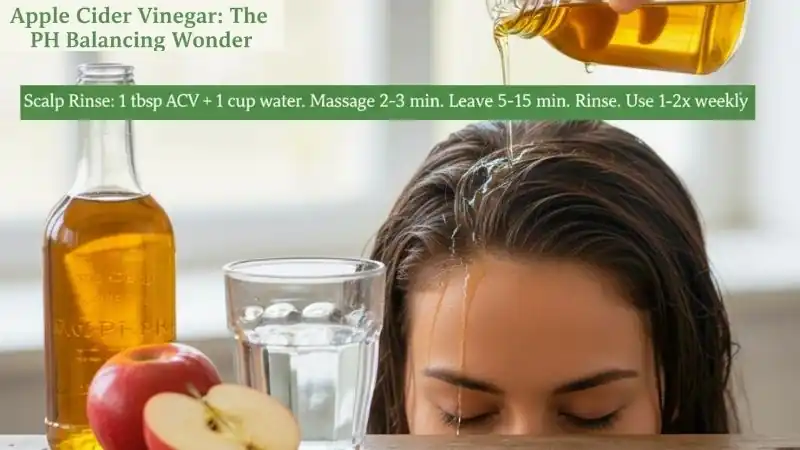
Apple cider vinegar (ACV) is a favorite among natural health enthusiasts for good reason. It balances your scalp’s pH levels, has antimicrobial properties, and removes product buildup that can contribute to dandruff.
The acetic acid in ACV-Apple cider vinegar creates an environment where Malassezia yeast struggles to survive while supporting the growth of beneficial scalp bacteria.
Apple Cider Vinegar Scalp Rinse:
- Mix 1 tablespoon of raw, unfiltered apple cider vinegar with 1 cup of water
- After shampooing, pour the mixture over your scalp
- Massage gently for 2-3 minutes
- Let it sit for 5-15 minutes
- Rinse thoroughly with cool water
- Use 1-2 times weekly
Important Note: Always dilute ACV before applying it to your scalp. Undiluted vinegar can irritate and damage your hair’s protective cuticle.
4. Aloe Vera: Soothing Relief with Antifungal Benefits
Aloe vera gel isn’t just for sunburns—it’s a powerful dandruff remedy with antifungal, anti-inflammatory, and deeply moisturizing properties. Studies show that aloe vera improved seborrheic dermatitis symptoms by 80% in research participants.
The gel contains enzymes that break down dead skin cells while its cooling effect soothes itching and irritation.
Aloe Vera Scalp Treatment:
- Extract fresh gel from an aloe vera leaf or use 100% pure store-bought gel
- Apply a generous amount directly to your scalp
- Massage gently and leave on for 30-45 minutes
- Rinse with lukewarm water, then shampoo as usual
- Repeat 2-3 times weekly
Combination Recipe: Mix 2 tablespoons of aloe vera gel with 1 tablespoon of coconut oil and 5 drops of tea tree oil for a triple-action dandruff treatment.
5. Neem: Ancient Ayurvedic Dandruff Fighter
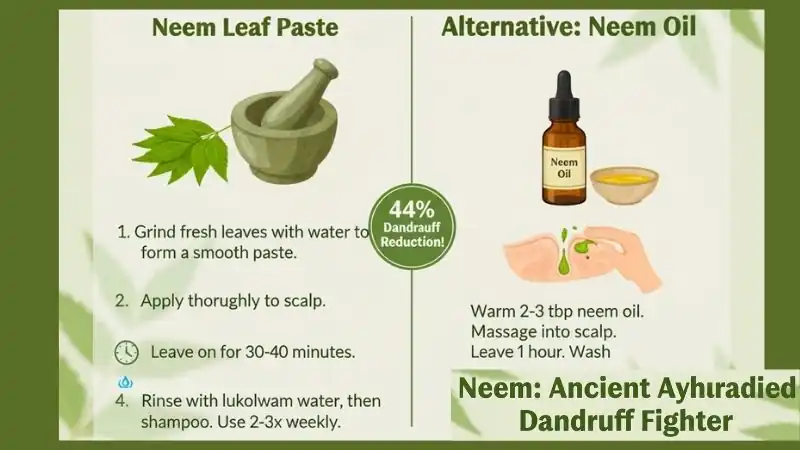
Neem has been used in traditional Indian medicine for centuries, and modern research confirms its effectiveness against dandruff. A clinical study found that 44% of participants had eliminated their dandruff after regular neem leaf paste applications.
Neem’s potent antibacterial and antifungal compounds directly target the microorganisms causing scalp problems.
Neem Leaf Paste for Dandruff:
- Grind a handful of fresh neem leaves with enough water to form a smooth paste
- Apply the paste thoroughly to your scalp
- Leave on for 30-40 minutes
- Rinse with lukewarm water, then shampoo
- Use 2-3 times weekly for visible results
Alternative: If fresh neem leaves aren’t available, warm 2-3 tablespoons of neem oil and massage it into your scalp. Leave for 1 hour before washing.
6. Fenugreek Seeds: Protein-Rich Scalp Nourishment
Fenugreek seeds (methi) are packed with proteins, biotin, and compounds that fight fungus, bacteria, and inflammation. They’re particularly effective for dandruff accompanied by hair fall.
Fenugreek Dandruff Remedy:
- Soak 2-3 tablespoons of fenugreek seeds in water overnight
- Next morning, grind the softened seeds into a smooth paste
- Apply the paste to your scalp and leave for 30-40 minutes
- Rinse with lukewarm water, then shampoo gently
- Use twice weekly
Enhanced Recipe: Mix the fenugreek paste with 2 tablespoons of yogurt for added probiotics and cooling benefits.
7. Baking Soda: Gentle Exfoliation for Flake Removal
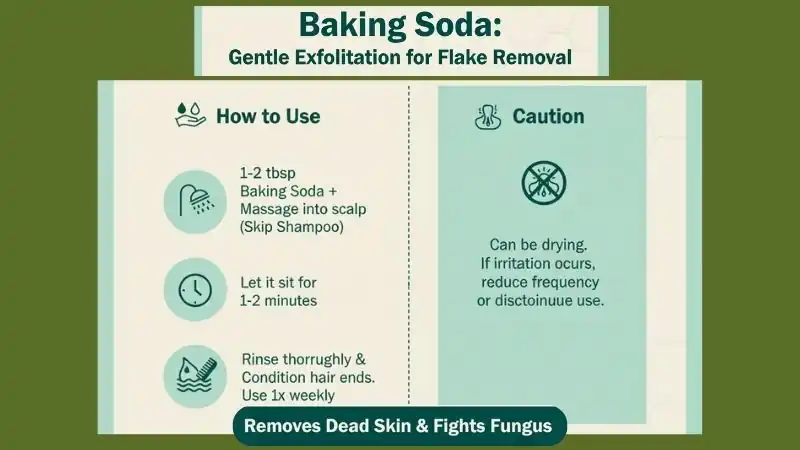
Baking soda acts as a mild exfoliant that removes dead skin cells and product buildup, while its antifungal properties help control Malassezia yeast.
How to Use:
- Wet your hair thoroughly
- Take 1-2 tablespoons of baking soda and massage directly into your scalp (skip the shampoo)
- Let it sit for 1-2 minutes
- Rinse thoroughly and condition your hair ends
- Use once weekly
Caution: Baking soda can be drying for some scalp types. If you notice increased dryness or irritation, reduce frequency or discontinue use.
8. Lemon Juice: Citrus Power Against Fungus
The citric acid in fresh lemon juice helps combat fungal activity while maintaining your scalp’s pH balance. It’s especially effective for oily dandruff.
Lemon Scalp Treatment:
- Massage 2 teaspoons of fresh lemon juice directly onto your scalp
- Leave for 2-3 minutes
- Rinse with lukewarm water
- Follow with a diluted lemon rinse: mix the juice of half a lemon with 1 cup of water and pour over the scalp
- Final rinse with plain water
- Use 1-2 times weekly
Tip: Lemon can lighten hair with sun exposure, so be mindful if you have color-treated hair.
9. Olive Oil: Overnight Moisturizing Treatment
Extra-virgin olive oil is excellent for treating dry scalp and dandruff. It moisturizes deeply while loosening stubborn flakes.
Overnight Treatment:
- Warm 3-4 tablespoons of olive oil
- Massage into scalp before bed
- Cover your pillow with a towel
- Wash out thoroughly in the morning
- Use 1-2 times weekly
10. Garlic: Fast-Acting Antimicrobial Solution
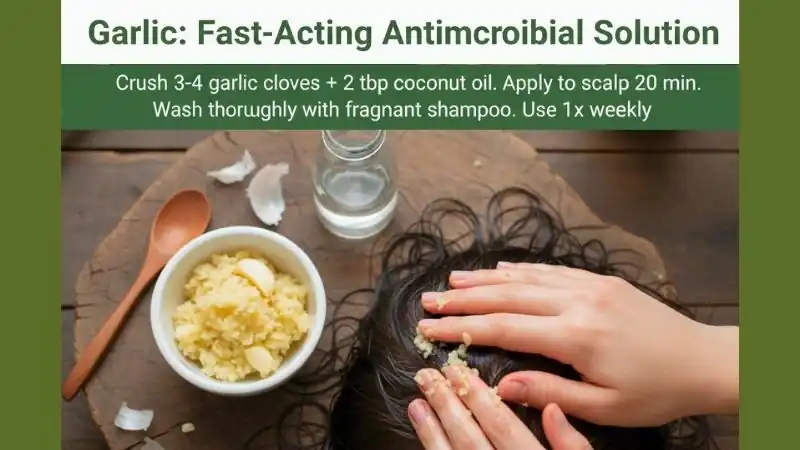
Garlic’s powerful antimicrobial compounds make it effective for stubborn dandruff, though the smell can be strong.
Quick Application:
- Crush 3-4 garlic cloves and mix with 2 tablespoons of coconut oil
- Apply to the scalp for 20 minutes
- Wash thoroughly with a fragrant shampoo
- Use once weekly
Additional Quick Remedies Worth Trying:
- Raw Honey: Mix 1 tablespoon of honey with 2 tablespoons of warm water. Apply to the scalp for 30 minutes before washing. Honey’s natural antibacterial properties soothe and heal.
- Yogurt: Apply plain, unsweetened yogurt to your scalp for 30 minutes. The probiotics support a healthy scalp bacteria balance.
- Green Tea: Brew strong green tea, let it cool, and use it as a final rinse after shampooing. Its antioxidants reduce inflammation.
Lifestyle Changes to Prevent Dandruff Long-Term

While dandruff remedies provide relief, preventing recurrence requires lifestyle adjustments.
Balance Your Scalp Hygiene Routine
Finding your personal sweet spot for hair washing is crucial. Washing too frequently strips protective oils, while infrequent washing allows buildup that feeds fungus.
Best Practices:
- Most people benefit from washing 2-3 times weekly
- Use lukewarm water instead of hot water, which irritates the scalp
- Massage shampoo gently for 2-3 minutes before rinsing
- Keep hair brushes and accessories clean
- Limit styling products that cause buildup
Eat for Scalp Health
Your diet directly impacts your scalp’s condition. Incorporating these nutrients can significantly reduce dandruff:
Foods to Emphasize:
- Omega-3 fatty acids: Salmon, mackerel, walnuts, flaxseeds, and chia seeds reduce inflammation
- Zinc-rich foods: Pumpkin seeds, lentils, chickpeas, and beef support scalp healing
- B vitamins: Leafy greens, whole grains, eggs, and nutritional yeast
- Probiotics: Yogurt, kefir, and fermented foods balance your body’s microbiome
Foods to Reduce:
- Excess sugar and refined carbohydrates (they feed yeast)
- Greasy, fried foods that increase oil production
- Alcohol, which can trigger inflammation
Manage Stress Effectively
Stress compromises your immune system, making it harder to control fungal overgrowth. Regular stress management isn’t just good for your mind—it’s essential for your scalp.
Stress-Reduction Strategies:
- Practice 10-15 minutes of daily meditation or deep breathing
- Exercise regularly to improve scalp circulation
- Prioritize 7-8 hours of quality sleep
- Take breaks throughout your workday
- Try yoga or tai chi for gentle movement and relaxation
Protect Your Scalp from Environmental Stress
Seasonal Adjustments:
- Use a humidifier during dry winter months
- Increase moisture treatments when the weather changes
- Protect your scalp from harsh sun with hats
- Spend time outdoors regularly for fresh air exposure
When to See a Doctor About Your Dandruff

While most dandruff responds well to home remedies, certain situations require professional medical attention.
Seek dermatologist care if:
- Your dandruff persists after 3-4 weeks of consistent home treatment
- You develop thick, crusty scales or widespread scalp coverage
- Intense itching disrupts your sleep or daily activities
- You notice red, inflamed patches that might be infected
- Dandruff spreads to your face, eyebrows, ears, or chest
- You experience significant hair loss along with flaking
These symptoms might indicate seborrheic dermatitis, psoriasis, eczema, or scalp ringworm—conditions that need prescription treatments like stronger antifungal medications, topical corticosteroids, or specialized therapies.
Creating Your Personalized Dandruff Treatment Plan
Every scalp is unique. Here’s how to build a routine that works specifically for you:
Step 1: Identify Your Scalp Type
Is your scalp oily, dry, or a combination? This determines which remedies will work best.
Step 2: Start Simple
Choose 1-2 remedies from the list above. Tea tree oil and coconut oil are excellent starting points for most people.
Step 3: Be Consistent
Apply your chosen remedy 2-3 times weekly for at least 2-3 weeks before judging results. Natural treatments take time to show full effects.
Step 4: Track Your Progress
Keep notes about what you try and how your scalp responds. This helps you identify patterns and refine your approach.
Step 5: Combine Strategically
Once you know what works, combine complementary remedies. For example, use a tea tree oil shampoo with a pre-wash coconut oil treatment.
Step 6: Add Lifestyle Support
Implement dietary changes and stress management alongside topical treatments for comprehensive results.
Step 7: Maintain Your Results
Don’t stop treatments the moment flakes disappear. Continue a maintenance routine with weekly applications to prevent recurrence.
Over-the-Counter Solutions for Dandruff Remedies
If home remedies aren’t providing enough relief, or your dandruff keeps coming back, it may be time to try over-the-counter (OTC) solutions. These shampoos and lotions are designed to target the causes of dandruff—including fungal growth, excessive oil production, and scalp irritation—using active ingredients proven to work quickly and safely.
How Do Over-the-Counter Dandruff Remedies Work?
OTC dandruff treatments typically contain medicated ingredients that stop fungal growth, exfoliate flakes, and soothe inflammation. Most are easy to use—just swap them with your regular shampoo, following instructions for best results.
Common Active Ingredients and Their Benefits:
- Zinc Pyrithione (1-2%)
This is one of the most popular ingredients in dandruff shampoos. It kills fungus and bacteria that lead to flaking and irritation, making it effective for most mild and moderate cases. - Selenium Sulfide
Reduces scalp fungus and slows the rate at which your skin cells shed. It’s great for oily scalps but may discolor light-colored hair if not rinsed thoroughly. - Ketoconazole
A powerful antifungal found in prescription-level and some OTC shampoos. It targets Malassezia yeast, which causes many cases of persistent dandruff. - Salicylic Acid
Helps lift flakes off the scalp for easier washing away. It doesn’t treat the underlying fungus but is helpful for those with thick scaling. - Coal Tar
Slows down the growth and shedding of skin cells on your scalp. It’s often used for severe dandruff and other skin conditions, but it can stain hair and has a strong odor. - Piroctone Olamine
A newer antifungal agent that’s gentle and family-safe, often found in premium OTC and salon formulas.
How to Use OTC Dandruff Shampoos Effectively
- Frequency:
Use your dandruff shampoo 2-3 times per week initially. Some people benefit from daily use, but follow the label instructions for your specific product. - Application Method:
Wet your hair, apply the shampoo to the scalp, and massage gently for 2-5 minutes. This ensures the active ingredients reach your skin. - Rinsing Well:
Rinse thoroughly to avoid buildup, especially if using selenium sulfide or coal tar products. - Consistency:
Visible results typically appear after 5–10 washes. Continue to use it to maintain a flake-free scalp.
Choosing the Right OTC Solution for You
- For mild, ordinary dandruff, start with zinc pyrithione or salicylic acid shampoos.
- For severe or stubborn dandruff, look for ketoconazole or selenium sulfide formulations.
- If you have sensitive skin, try products with piroctone olamine or those labeled “gentle,” free of harsh chemicals and fragrances.
Tips for Success
- Rotate between remedies if one loses effectiveness.
- Avoid using multiple medicated shampoos at the same time.
- Maintain scalp hygiene—clean brushes, wash pillowcases, and limit styling products.
Our Choice of Shampoo: Nizoral Anti-Dandruff Shampoo
Conclusion: Your Path to a Healthy, Flake-Free Scalp Starts Today
Dealing with dandruff can feel frustrating, but you now have a comprehensive toolkit of proven dandruff remedies at your fingertips. From the antifungal power of tea tree oil to the soothing benefits of aloe vera, natural solutions offer effective alternatives to harsh chemical treatments.
Remember, the key to success lies in consistency and patience. Your scalp didn’t develop dandruff overnight, and healing takes time. Start with one or two remedies that appeal to you—perhaps the simple yet powerful tea tree oil or the nourishing coconut oil treatment. Give your chosen approach at least 2-3 weeks of consistent application before expecting dramatic results.
Beyond topical treatments, don’t underestimate the power of lifestyle changes. Managing stress, eating nutrient-rich foods, and maintaining proper scalp hygiene create the foundation for long-term scalp health. These changes benefit not just your scalp, but your overall well-being.
Your Action Plan This Week:
Choose one remedy from this guide and try it twice this week. Note how your scalp feels and looks. Small, consistent steps lead to lasting change.
If your dandruff persists despite your best efforts, remember that seeking professional help is a sign of self-care, not defeat. Dermatologists have additional tools that can help when home remedies aren’t enough.
You deserve to feel confident and comfortable in your own skin—or scalp! With these natural dandruff remedies and the commitment to care for yourself, that flake-free future is well within reach. Start today, stay consistent, and watch your scalp transform.
29 Sources:
Noble Home Remedies relies on peer-reviewed studies, academic research institutions, and medical associations for accuracy and reliability while avoiding tertiary references. Our editorial policy provides more information about how we ensure our content is accurate and up-to-date.
- Dandruff – Symptoms and causes
https://www.mayoclinic.org/diseases-conditions/dandruff/symptoms-causes/syc-20353850 - Dandruff: Causes, Treatment, and Prevention
https://www.healthline.com/health/dandruff-itchy-scalp - Dandruff: Causes and treatments
https://www.medicalnewstoday.com/articles/152844 - A Complete Guide to Dandruff Causes, Symptoms & Treatments
https://innovist.com/blogs/all/dandruff-causes-and-treatment - How to Remove Dandruff in One Day with Home Remedies?
https://www.hairmdindia.com/blog/how-to-remove-dandruff-in-one-day-with-home-remedies - 10 Home Remedies to Get Rid of Dandruff Naturally
https://www.healthline.com/nutrition/ways-to-treat-dandruff - Dandruff Treatments and Home Remedies
https://www.webmd.com/skin-problems-and-treatments/understanding-dandruff-treatment - Dandruff – Diagnosis and treatment
https://www.mayoclinic.org/diseases-conditions/dandruff/diagnosis-treatment/drc-20353854 - What are Dandruff Symptoms and Their Causes?
https://www.careinsurance.com/blog/health-insurance-articles/what-are-dandruff-symptoms-and-their-causes - Tea Tree Oil for Dandruff: Does it Work, Uses, and Benefits
https://www.healthline.com/health/tea-tree-oil-for-dandruff - Treatment of dandruff with 5% tea tree oil shampoo
https://pubmed.ncbi.nlm.nih.gov/12451368/ - Should You Use Coconut Oil for Dandruff?
https://www.verywellhealth.com/coconut-oil-for-dandruff-efficacy-and-how-to-use-it-5193196 - Is Coconut Oil Helpful In Removing Dandruff?
https://www.headandshoulders.co.in/en-in/healthy-hair-and-scalp/dandruff/dandruff-home-remedies/coconut-oil-for-dandruff - 5 ways to use apple cider vinegar for dandruff issues
https://timesofindia.indiatimes.com/life-style/beauty/5-ways-to-use-apple-cider-vinegar-for-dandruff-issues/photostory/119592292.cms - Apple Cider Vinegar For Dandruff, How To Use, Benefits
https://juicychemistry.com/blogs/hair-care/apple-cider-vinegar-for-dandruff-how-to-use-benefits - Aloe Vera for Dandruff: Does It Work?
https://www.healthline.com/health/aloe-vera-for-dandruff - Aloe Vera for Dandruff: Benefits & Hair Mask for Relief
https://www.bebeautiful.in/all-things-hair/hair-concerns/how-to-use-aloe-vera-to-cure-dandruff-naturally - Can Aloe Vera Gel Prevent Dandruff? – Dubai
https://www.drbatras.ae/can-aloe-vera-gel-prevent-dandruff - Effect of Neem Leaf Paste Application on Dandruff – PMC
https://pmc.ncbi.nlm.nih.gov/articles/PMC11999905/ - 5 effective ways to use neem leaves to cure dandruff
https://timesofindia.indiatimes.com/life-style/beauty/5-effective-ways-to-use-neem-leaves-to-cure-dandruff/photostory/118062644.cms - Can Fenugreek Help Treat Dandruff?
https://www.headandshoulders.co.in/en-in/healthy-hair-and-scalp/dandruff/dandruff-home-remedies/fenugreek-for-dandruff - How this Methi-Curd hair pack can forever remove your dandruff problem
https://timesofindia.indiatimes.com/life-style/beauty/how-this-methi-curd-hair-pack-can-forever-remove-your-dandruff-problem/articleshow/112398795.cms - Best Shampoo for Seborrheic Dermatitis: Natural, Medicated
https://www.healthline.com/health/shampoo-seborrheic-dermatitis - Pyrithione Zinc – The World’s No. 1 Anti-Dandruff Ingredient
https://headandshoulders.com/en-us/healthy-hair-and-scalp/dandruff/pyrithione-zinc-how-the-best-dandruff-treatment-works - 8 Lifestyle Changes to Help Reduce and Prevent Dandruff
https://www.buywow.in/blog/lifestyle-to-prevent-dandruff - Healthy Habits for a Flake-Free Scalp: Lifestyle Guidance
https://www.drskinclinics.com/healthy-habits-for-a-flake-free-scalp-lifestyle-guidance-for-managing-dandruff-at-dr-skin-clinic/ - When to See a Doctor for Severe Dandruff Treatments
https://svenson.com.ph/blog/severe-dandruff-treatments/ - Should I See A Dermatologist For Dandruff? Symptoms Of Seborrheic Dermatitis
https://www.northstardermatology.com/blog/should-i-see-a-dermatologist-for-dandruff-symptoms-of-seborrheic-dermatitis/ - Dandruff – When Should You Visit a Dermatologist
https://www.lybrate.com/topic/dandruff-when-should-you-visit-a-dermatologist/f1d29598c2e9f5ea50808b3cb4422d6f
Trust in your purchase:
Every product featured on our site has been carefully researched and selected based on quality, customer ratings, and positive reviews to ensure you receive excellent value for your money.
Please note:
This post contains affiliate links. If you make a purchase through these links, we may earn a small commission at no additional cost to you. This helps support our site and allows us to continue bringing you valuable content. Thank you!
Thank you for your precious time spent with NobleHomeRemedies.
You may also like:
Fall Allergies: Symptoms, Triggers, and Reliable Remedies
Fall Allergies: Symptoms and Triggers: , Reliable Remedies Spring is over, summer is over now…
Home Remedies for Stomach Acidity
10 Best Home Remedies for Stomach Acidity – Treat Naturally Are you suffering from stomach…
Home Remedies for Bunions
Home Remedies for Bunions A bunion is a bone growth on the side and bottom…
Foods for Toddler Constipation
What to Give a Toddler for Constipation?: 8 Natural Foods Adults know how uncomfortable constipation…
Hearing Loss Causes and Treatments
Hearing Loss Causes and Treatments: Improved Your Earing Ability Hearing loss causes are many. There…
Witch Hazel for Yeast Infection
Natural Witch Hazel for Yeast Infection: Antimicrobial Are you feeling itchy and uncomfortable in your…



